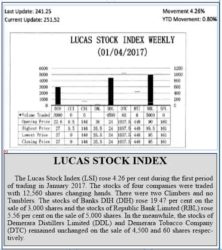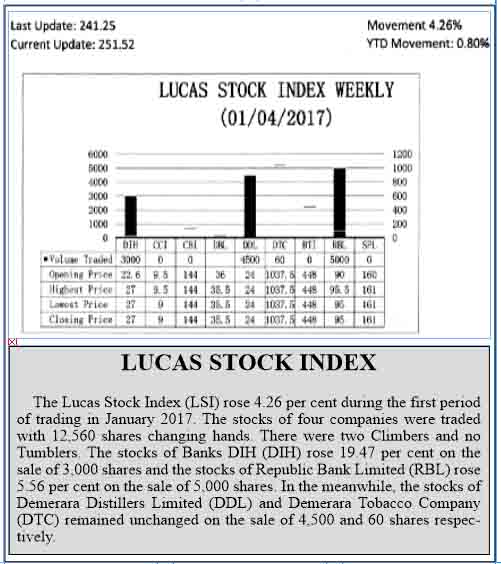Rice
Last week’s article discussed the things necessary to achieve stability and durability in the national economy. It recognized too that cooperation between the government and the private sector was necessary to achieve both stability and durability.
In that regard, the article examined the contribution from both actors that was needed in order to make things happen. Given the role that government played in the productive sectors, an assessment of its contribution to the industries in which it participates was also undertaken. Electricity, oil, sugar and rice were discussed briefly. This second part of the article will continue to examine the other industries and their issues. The rice industry, it was observed, needed to be encouraged.
The rice industry has shown that it can respond favourably to new opportunities with positive results for all participants. According to data from the 2014 Annual Report of the Guyana Rice Development Board (GRDB), the industry has shown stability and durability with both expanded paddy production and rice yields over many years.
However, rice is experiencing several challenges. In addition to output which has fallen about 12 per cent, export revenue from rice was expected to decline by 17 per cent. This decline represents a challenge which the government must rise to.
A factor that periodically interferes with rice production is drainage and irrigation. To the extent that the government continues to address that situation, rice production should grow.
It should be noted too that, as a primary commodity, rice production responds to demand. Rice farmers have already shown that they have the capability of responding to demand opportunities. Given its ability to respond to market signals, it is critical to find new markets for rice simply because the opportunity cost would be lower production and lower revenues.
The withdrawal of additional income from the economy is not a good thing as a consequence of the already sharp reduction in investment in several industries and sectors. Consideration should be given to efforts at producing different varieties of rice to increase market opportunities. Some advice to this effect has been offered by the government to rice farmers.
One should not ignore the value-added that could be derived from rice. Many products have rice as a base in their production.
These include rice flour, rice cereals and rice cakes. Rice therefore can also be sold in the intermediate consumption market, especially when farmers run up against already saturated foreign markets. Government therefore needs to forge backward and forward linkages with the rice industry to help diversify and widen the consumption base for rice.
MARDS
The government owns the MARDS or, as it is often called, the Burma Rice mills. The operations at MARDS represent a good example of how government and the private sector could cooperate. For many years, officials at MARDS did not say much about their activities, but it was known that MARDS leased the nearly 3,000 acres of land under its control to rice farmers and other agents. In light of a desire to keep rice production high, the new administration has adopted a policy of inclusion where the use of its MARDS lands is concerned. As such, it has made it possible for interested residents in the area to lease land for the purpose of rice cultivation.
The policy of economic inclusion extends to operational support. MARDS has decided to set up a pesticide centre to make it easier for small farmers to access material to reduce the risk of crop loss. MARDS also plans to rent farm equipment to those farmers who cannot afford to own their own equipment. These initiatives represent ways in which government can help to stimulate production in the rice industry during 2017 and beyond.
The milling complex has been outsourced also to a private company. The government has opted to let one of the largest milling facilities come under private investment. Government’s contribution in effect is made through private investment in its lands.
Forestry and livestock
In addition to rice, the forestry and livestock industries have suffered significant setbacks. It would appear that the forestry sector needs a reset. The industry operated for several years on the expectation of forward linkages between the production of raw logs and finished light manufactured products. Exports were expected to consist of a combination of raw materials and whatever finished products were produced. This did not happen to the degree anticipated and many Guyanese felt that the industry was operating outside of agreed investment limits.
As a consequence, the industry came under intense scrutiny and the weakness of the business model of several participating entities was exposed.
The demise of the industry is not a consequence of lack of production incentives, but instead the unreliability of the chosen business model of some key players. The challenge for the industry is to find new investors who are capable of integrating the production of raw materials with a stream of value-added revenue. The speed by which this could be done will influence the success of the adjustment efforts needed to prevent the economy from sliding backwards in 2017.
When the realities of milk production are added, the attention that the agricultural and allied sectors needs looms large. Milk production is not yielding the returns needed to keep the industry alive. Many of the woes are ascribed to low demand.
There is a clear need to understand the reason for the decline in demand. Such a study would help to identify the real problem and enable the correct response to be formulated.
Durability depends on government support as part of its broader agricultural drive. This industry could therefore do with some support from the government to enable it to become more productive and competitive.
Construction
The situation in the construction industry needs to be looked at as well. With the number of households increasing, it is surprising that the pace of housing construction is slowing. This is an area where both the private investor and government can cooperate to bring improvements in construction activity. Stability and durability matter. Independent assessments have already shown that housing demand is greater than housing supply. This represents an area in which economic activity can be boosted. Some attention needs to be given to enabling contractors and private developers to operate with some ease.
Derived demand
There are some productive industries that are dependent on the level of activity in other sectors. For example, paint production depends on building construction. And so is the demand for products like sand and cement which also depend on implementation of public infrastructure programmes. Some services are useless also on their own. Demand for the service is derived from demand for other products.
Transportation and storage of imported goods is one of those services. The shipping industry is a highly concentrated industry with about five active operators of port and related services. Eighty per cent of the industry is in the hands of the private sector while the other 20 per cent is in the hands of the government.
This industry is dependent on external trade. The export performance of sugar, rice and timber creates concern for the shipping industry. It is true also about imports.
 Where imports are concerned, one could expect a further decline with higher oil prices and the threat of lower production.
Where imports are concerned, one could expect a further decline with higher oil prices and the threat of lower production.
Already items used in intermediate consumption have declined and were likely to decline further if the beneficiary industries were unable to improve. This risk ought to be of direct concern to the government since it operates in the shipping industry.
GNSC is one of those government entities that does not attract much public attention. The impact of GNSC on the industry is relatively small since it accounts for an estimated seven percent of the economic activity of the industry. Like the other entities in the industry, there is very little that the shipping company of the government can do. Consequently, it can only hope that the many institutional measures put in place help to reduce the cost of doing business enables demand for export and import activities to pick up.
Sustainable development
All of these things need to be situated in the context of the green economy envisaged for the country. The green development is linked to the sustainable development goals that all countries are required to pursue in search of mitigating climate change. Poverty and malnutrition are linked to housing and food production. They in turn are linked to the type of cities that we build in the future and the impact on production and consumption patterns. The inputs used in many industries are linked to health and climate change. The green economy therefore serves as a critical platform upon which many future interventions by the private sector and the government are to be built. The year 2017 presents an opportunity to pursue those goals in earnest.










